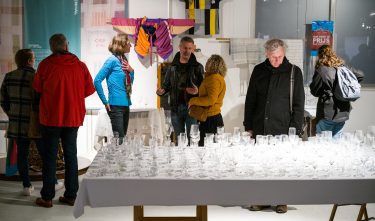Dutch Design Week 2021 has ended and had a relevant theme: 'The greater number'. This theme offered a refreshing view of the design profession where less can become more. Provided we were brave enough to make smart choices. In short, it is no longer about just blindly producing (much) more, but about the question: 'What is the real problem?' To then (re)define (eco)systems, production chains and value and revenue models in a designed way as an answer.
 1
1
Despite a somewhat gloomy context, this DDW became an edition that I left optimistically as chairman of the jury of the ‘Best Commissioning’ category of the Dutch Design Awards. Especially because the quality of the commissioning and the way of collaborating with the creative industry are essential success factors in ‘less can be more’. And we apply many of the same criteria as a jury of experts in this category. Because the much-needed transition from ‘more’ to ‘less ‘ is only possible with a different mentality, attitude and accompanying approaches.
— "The much-needed transition from 'more' to 'less' is only possible with a different mentality, attitude and corresponding approaches."
Now it’s clear that clients and the creative industry absolutely must work together. For example, with an approach that allows (requires) uncertainty. With trust in each other and the will to find a solution together in the longer term, no matter how unknown or tough the material may be. A basic condition is the active involvement of all disciplines, parties, stakeholders and users, preferably as quickly and structurally as possible. And … daring to allow experiments and make mistakes, precisely to learn from them and avoid having to repair at a later stage.
This makes it possible to discuss (eco)systems, production chains and value and revenue models and then redefine them. And that is indeed a lot more complicated than restyling an existing product, establishing a brand identity or developing the umpteenth app. It also concerns so-called ‘wicked problems’; design assignments that have to do with many different parties, uncertainties, often conflicting interests, a large number of dependencies and often start with an open end. For example: how do we keep our healthcare system up to scratch and make it future-proof? Or how do we digitise the government so that all citizens can use it without any problem?
— “It is crucial that we as clients and the creative industry really dare to embrace the complexity as mentioned earlier.”
Such a ‘wicked problem’ requires more than the traditional briefing and – with all due respect – ‘classic commissioning’. We are talking about very complex issues that require a different approach. The most important condition is a design process in which you start by letting go of certainties. An investigative method, not only talking but also daring to act together, and in this respect testing assumptions by testing prototypes and conducting experiments are essential. An eye for the broader perspective (people, planet, profit) is an important side effect.
The three nominations in this edition of the Dutch Design Awards provide convincing proof of how this works in practice. For example, GRRR and Boyan Slat’s Ocean Cleanup use an agile approach and a long-term approach based on a strongly supported vision. Together they create demonstrable support and growth for Slat’s well-known and sympathetic mission. The BioPartner 5 building shows where a paradigm shift (‘not demolition, but reuse and upcycling’) and the stakeholders’ active involvement leads. The first building in the Netherlands that meets the standards of the Paris Agreement with an approach and business model that invites others to follow its lead. And the winner, the Leiden Circulair warenhuis, demonstrates how daring to rethink, turning a problem into an opportunity, involving many disciplines and making new connections and unimagined combinations, leads to a scalable, smart solution that many recycling companies can take advantage of.
— “The innovation of the creative collaboration process is the first step to facilitate real change on a larger scale.”
In short: good commissioning and design (re)thinking leads to more value. And the innovation of the creative collaboration process is the first step to facilitate real change on a larger scale. Logically, in addition to flexibility and stamina, political skills are also badly needed. After all, anyone who wants to think about systems and value models should be prepared to do so. But … if we succeed, we as designers will be able to make a lasting impact: for our clients, their stakeholders, the (end) users and society as a whole. A wonderful challenge that we can tackle with the creative industry. I can’t wait!
Pieter Aarts, chair expert panel category Best Commissioning